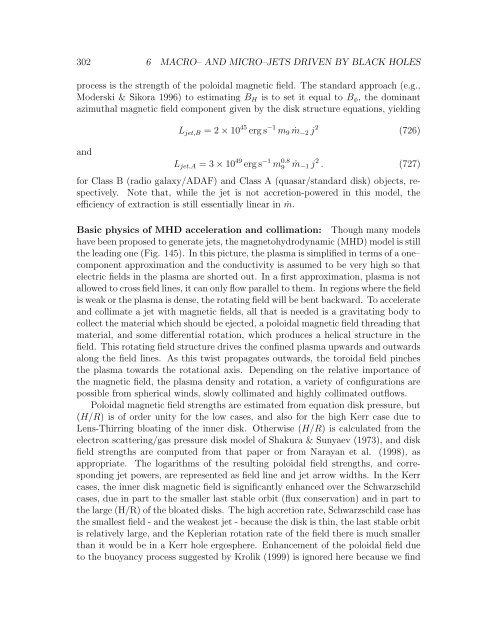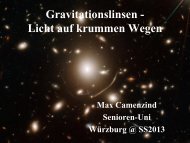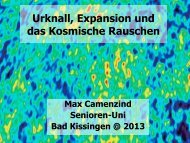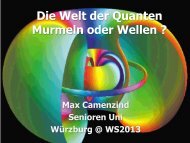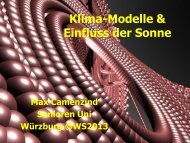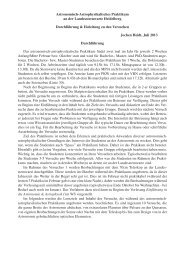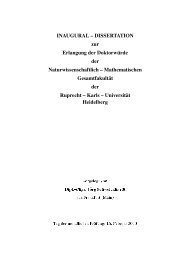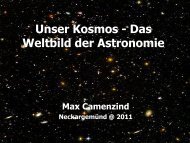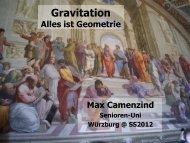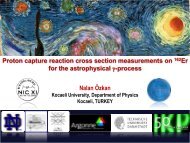Contents List of Figures
Contents List of Figures
Contents List of Figures
Create successful ePaper yourself
Turn your PDF publications into a flip-book with our unique Google optimized e-Paper software.
302 6 MACRO– AND MICRO–JETS DRIVEN BY BLACK HOLES<br />
process is the strength <strong>of</strong> the poloidal magnetic field. The standard approach (e.g.,<br />
Moderski & Sikora 1996) to estimating BH is to set it equal to Bφ, the dominant<br />
azimuthal magnetic field component given by the disk structure equations, yielding<br />
and<br />
Ljet,B = 2 × 10 45 erg s −1 m9 ˙m−2 j 2<br />
(726)<br />
Ljet,A = 3 × 10 49 erg s −1 m 0.8<br />
9 ˙m−1 j 2 . (727)<br />
for Class B (radio galaxy/ADAF) and Class A (quasar/standard disk) objects, respectively.<br />
Note that, while the jet is not accretion-powered in this model, the<br />
efficiency <strong>of</strong> extraction is still essentially linear in ˙m.<br />
Basic physics <strong>of</strong> MHD acceleration and collimation: Though many models<br />
have been proposed to generate jets, the magnetohydrodynamic (MHD) model is still<br />
the leading one (Fig. 145). In this picture, the plasma is simplified in terms <strong>of</strong> a one–<br />
component approximation and the conductivity is assumed to be very high so that<br />
electric fields in the plasma are shorted out. In a first approximation, plasma is not<br />
allowed to cross field lines, it can only flow parallel to them. In regions where the field<br />
is weak or the plasma is dense, the rotating field will be bent backward. To accelerate<br />
and collimate a jet with magnetic fields, all that is needed is a gravitating body to<br />
collect the material which should be ejected, a poloidal magnetic field threading that<br />
material, and some differential rotation, which produces a helical structure in the<br />
field. This rotating field structure drives the confined plasma upwards and outwards<br />
along the field lines. As this twist propagates outwards, the toroidal field pinches<br />
the plasma towards the rotational axis. Depending on the relative importance <strong>of</strong><br />
the magnetic field, the plasma density and rotation, a variety <strong>of</strong> configurations are<br />
possible from spherical winds, slowly collimated and highly collimated outflows.<br />
Poloidal magnetic field strengths are estimated from equation disk pressure, but<br />
(H/R) is <strong>of</strong> order unity for the low cases, and also for the high Kerr case due to<br />
Lens-Thirring bloating <strong>of</strong> the inner disk. Otherwise (H/R) is calculated from the<br />
electron scattering/gas pressure disk model <strong>of</strong> Shakura & Sunyaev (1973), and disk<br />
field strengths are computed from that paper or from Narayan et al. (1998), as<br />
appropriate. The logarithms <strong>of</strong> the resulting poloidal field strengths, and corresponding<br />
jet powers, are represented as field line and jet arrow widths. In the Kerr<br />
cases, the inner disk magnetic field is significantly enhanced over the Schwarzschild<br />
cases, due in part to the smaller last stable orbit (flux conservation) and in part to<br />
the large (H/R) <strong>of</strong> the bloated disks. The high accretion rate, Schwarzschild case has<br />
the smallest field - and the weakest jet - because the disk is thin, the last stable orbit<br />
is relatively large, and the Keplerian rotation rate <strong>of</strong> the field there is much smaller<br />
than it would be in a Kerr hole ergosphere. Enhancement <strong>of</strong> the poloidal field due<br />
to the buoyancy process suggested by Krolik (1999) is ignored here because we find


